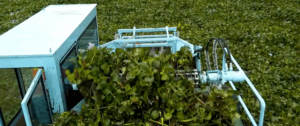Waterfront properties—whether lakes, ponds, or rivers—are prized for their natural beauty and recreational value, but maintaining these areas often requires specialized equipment and strategies. Over time, aquatic weeds, algae blooms, and sediment buildup can transform a once pristine shoreline into an overgrown, murky environment that’s difficult to enjoy. That’s where obscure but essential tools for waterfront management come in. From aquatic weed harvesters to sediment dredges and aeration systems, these tools play a crucial role in restoring and preserving the health of waterfront ecosystems. They not only help property owners and municipalities get rid of lake weeds but also ensure that these scenic areas remain safe, functional, and enjoyable for years to come.
Nuisance Vegetation Control
One of the most effective and increasingly popular tools for nuisance vegetation control is the aquatic weed harvester. Operating much like an underwater lawnmower, this specialized machine cuts, collects, and removes unwanted aquatic plants such as milfoil, hydrilla, and water hyacinth. These weeds can quickly take over a lake, choking out native plants, reducing oxygen levels, and making boating, swimming, and fishing nearly impossible. By mechanically removing them, aquatic weed harvesters provide an environmentally friendly alternative to chemical treatments, preserving water quality while improving the overall appearance and usability of the waterfront. Regular harvesting during peak growing seasons can prevent future infestations and maintain a balance in the aquatic ecosystem.
Interesting Hand Tools
 Beyond weed harvesting, nuisance management includes several other innovative tools. Hydrorakes and mechanical dredges are particularly useful for removing accumulated organic material and muck from the bottom of lakes and ponds. Over time, sediment buildup can make shallow areas unusable and contribute to further weed growth. Dredging rejuvenates these zones by restoring depth and improving water circulation. Meanwhile, aeration systems, which pump oxygen into the water, help prevent algae blooms and fish kills by increasing dissolved oxygen levels and breaking down organic debris. Together, these devices create a healthier aquatic environment that supports fish, wildlife, and recreation.
Beyond weed harvesting, nuisance management includes several other innovative tools. Hydrorakes and mechanical dredges are particularly useful for removing accumulated organic material and muck from the bottom of lakes and ponds. Over time, sediment buildup can make shallow areas unusable and contribute to further weed growth. Dredging rejuvenates these zones by restoring depth and improving water circulation. Meanwhile, aeration systems, which pump oxygen into the water, help prevent algae blooms and fish kills by increasing dissolved oxygen levels and breaking down organic debris. Together, these devices create a healthier aquatic environment that supports fish, wildlife, and recreation.
Nutrient Monitoring
 In addition to mechanical tools, integrated nuisance management programs are essential for long-term success. This involves monitoring nutrient levels, controlling shoreline erosion, and using biological controls such as grass carp or beneficial bacteria to naturally suppress weed growth. Prevention is just as important as removal—installing vegetative buffer zones along the shoreline can help filter runoff and limit nutrient pollution, which is a major contributor to weed and algae overgrowth. For waterfront property owners and lake associations, combining these approaches leads to sustainable results that balance recreation, aesthetics, and ecological health.
In addition to mechanical tools, integrated nuisance management programs are essential for long-term success. This involves monitoring nutrient levels, controlling shoreline erosion, and using biological controls such as grass carp or beneficial bacteria to naturally suppress weed growth. Prevention is just as important as removal—installing vegetative buffer zones along the shoreline can help filter runoff and limit nutrient pollution, which is a major contributor to weed and algae overgrowth. For waterfront property owners and lake associations, combining these approaches leads to sustainable results that balance recreation, aesthetics, and ecological health.
Managing a waterfront area requires both science and strategy. While the tools used may seem obscure, they are vital for keeping these environments vibrant and accessible. Aquatic weed harvesters, dredging equipment, and aeration systems are not just maintenance tools—they are investments in the long-term enjoyment and preservation of water resources. When properly managed, a lake or pond remains a place for swimming, boating, and reflection rather than a tangled mess of weeds and algae. By taking proactive steps to get rid of lake weeds and maintain ecological balance, property owners and communities ensure that their waterfronts continue to shine as natural treasures for generations to come.